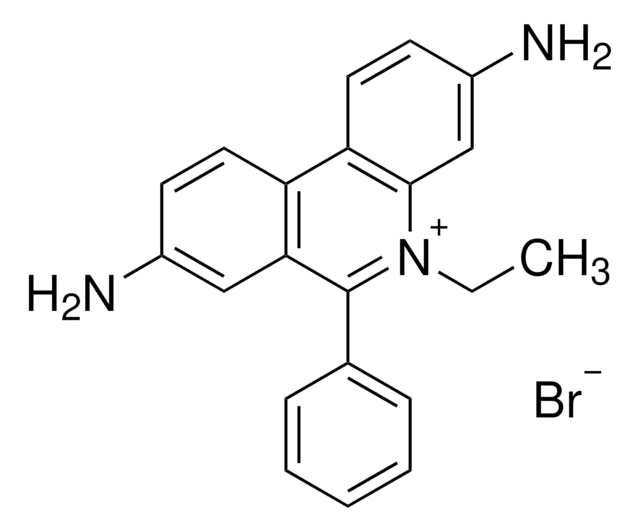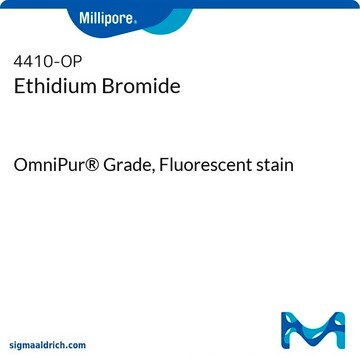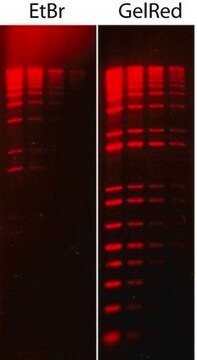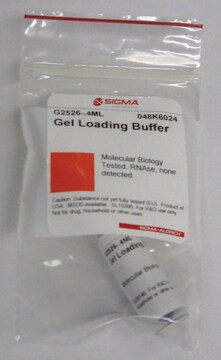Kluczowe dokumenty
E7637
Ethidium bromide
BioReagent, for molecular biology, powder
Synonim(y):
3,8-Diamino-5-ethyl-6-phenylphenanthridinium bromide, EtBr, Homidium bromide
About This Item
Polecane produkty
klasa czystości
Molecular Biology
for molecular biology
Poziom jakości
linia produktu
BioReagent
Formularz
powder
metody
electrophoresis: suitable
mp
260-262 °C (dec.) (lit.)
fluorescencja
λex 360 nm; λem 590 nm in PBS
λex 526 nm; λem 605 nm (10 mM TBE; pH 8.0;)
λex 526 nm; λem 605 nm in aqueous buffer
przydatność
suitable for gel electrophoresis
ciąg SMILES
[Br-].CC[n+]1c(-c2ccccc2)c3cc(N)ccc3c4ccc(N)cc14
InChI
1S/C21H19N3.BrH/c1-2-24-20-13-16(23)9-11-18(20)17-10-8-15(22)12-19(17)21(24)14-6-4-3-5-7-14;/h3-13,23H,2,22H2,1H3;1H
Klucz InChI
ZMMJGEGLRURXTF-UHFFFAOYSA-N
Szukasz podobnych produktów? Odwiedź Przewodnik dotyczący porównywania produktów
Zastosowanie
Mutagen Frameshift, który interkaluje dwuniciowe DNA i RNA.
Działania biochem./fizjol.
Rekonstytucja
produkt powiązany
Hasło ostrzegawcze
Danger
Zwroty wskazujące rodzaj zagrożenia
Zwroty wskazujące środki ostrożności
Klasyfikacja zagrożeń
Acute Tox. 1 Inhalation - Acute Tox. 4 Oral - Muta. 2
Kod klasy składowania
6.1A - Combustible acute toxic Cat. 1 and 2 / very toxic hazardous materials
Klasa zagrożenia wodnego (WGK)
WGK 1
Temperatura zapłonu (°F)
Not applicable
Temperatura zapłonu (°C)
Not applicable
Środki ochrony indywidualnej
Eyeshields, Faceshields, Gloves, type P3 (EN 143) respirator cartridges
Wybierz jedną z najnowszych wersji:
Masz już ten produkt?
Dokumenty związane z niedawno zakupionymi produktami zostały zamieszczone w Bibliotece dokumentów.
Powiązane treści
Bromek etydyny jest dobrze znanym i szeroko stosowanym barwnikiem fluorescencyjnym w badaniach biotechnologicznych.
Nasz zespół naukowców ma doświadczenie we wszystkich obszarach badań, w tym w naukach przyrodniczych, materiałoznawstwie, syntezie chemicznej, chromatografii, analityce i wielu innych dziedzinach.
Skontaktuj się z zespołem ds. pomocy technicznej







